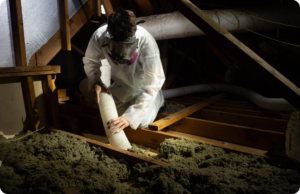Clutter can provide places for pests to breed and hide and block ventilation openings. Make sure to regularly clean wood piles, compost bins, and other debris away from the house and trim branches that may touch the roofline.
Monitoring means checking your landscape, building, or food garden to identify pests and evaluate their numbers and damage. This information helps guide control decisions. Visit Our Website to learn more.

Pests are a nuisance and can also cause damage that may result in expensive repair costs or health risks for people and pets. Preventing infestations is the best course of action to protect your property and safeguard your well-being. A few simple steps can be effective in keeping pests away:
1. Seal cracks and holes to prevent outside entry. This includes caulking or weather stripping around windows and doors, and sealing openings where utility lines and pipes enter and exit. 2. Minimize food sources and clutter. This means regularly cleaning counters and other surfaces to remove crumbs and spills, storing foods in airtight containers, and disposing of garbage in tightly sealed trash cans. It also involves removing weeds and trimming branches that come into contact with your home, as they can provide shelter for rodents, beetles, and other pests.
3. Eliminate standing water. This is particularly important in areas of your yard where water collects, such as around house plants and the refrigerator. Water can attract many types of pests, including mosquitoes, gnats, and flies. 4. Regularly inspect your property for pests. Perform a thorough inspection of your property, especially areas where pests are known to hide or nest, such as attics and crawl spaces. Look for droppings, gnaw marks, and other signs of pest activity.
5. Practice Integrated Pest Management (IPM). IPM is an ecosystem-based approach that utilizes methods such as habitat manipulation, modification of cultural practices, and use of resistant varieties to reduce the need for pesticides. Pesticides are used only after monitoring indicates they are needed according to established guidelines, and with the goal of minimizing harm to beneficial organisms, human beings, and property.
By taking the time to keep your property clean and tidy, eliminate sources of food, water, and shelter, and regularly inspect for pests, you can greatly reduce the risk of a pest infestation. Be sure to keep up with follow-up visits from your pest control company, as they will be able to identify any problems and take the necessary steps to protect you and your property.
Suppression
The goal of suppression is to reduce a pest population to a tolerable level using one or more control methods. Taking steps to prevent an infestation is the first step in this process. For example, regularly inspecting your home and removing sources of food, water and shelter is an effective way to deter pests from invading. In addition, cleaning contaminated areas and preventing moisture buildup in crawl spaces are also good preventative measures.
In addition to maintaining cleanliness, the most important preventative measure is to seal entry points that pests can use to enter homes. This includes thoroughly inspecting the exterior of your home for cracks, gaps and other openings and ensuring that doors and windows are properly sealed and fitted. It is also a good idea to install door sweeps and window screens.
Pests invade indoor environments in search of food, water, shelter or to reproduce. Infestations can result in contamination of products with disease causing agents, physical damage to buildings and their contents and the introduction of new organisms into the environment. These include the transfer of pathogens by rodents and cockroaches, fungi that cause diseases in plants and animals, parasitoids that live off other insects and eat them for their living, and spores that can contaminate food, water or surfaces.
For pests that can’t be controlled by prevention and suppression, eradication may be possible. This is often the case with foreign pests, such as Mediterranean fruit fly and gypsy moth, that are introduced into an area.
Typically, the best method of control is to apply the least-disturbing methods that are available, including biological and chemical controls. This will help to ensure that the pests are eliminated while minimizing the risk of human health, environmental impact and disruption of natural processes. The information gained from scouting and monitoring can be used to determine the most appropriate management technique for each situation. This can be done by applying threshold-based decision making. For instance, noticing a few wasps in your yard doesn’t warrant action, but seeing them everywhere is a sign that they’re out of control and a more intensive approach should be taken.
Eradication
Eradication is rarely the goal in outdoor pest control situations, unless it is specifically targeted at invasive species like the Mediterranean fruit fly and gypsy moth. In indoor environments, however, eradication is more often the objective. The pests most commonly targeted for eradication in commercial and residential settings include termites, bed bugs, cockroaches and other arachnids, rodents, mosquitoes, and flies.
Biological pest control relies on natural enemies—predation, parasitism, herbivory, or pathogens—to reduce populations of unwanted organisms. It can involve augmenting the existing natural enemies in an environment by releasing additional enemies, either in small batches over time or in large quantities at one time. Alternatively, the enemy may be genetically modified to make it more effective.
Pesticides are among the most familiar and widely used pest control products. They are effective against some pests but have a variety of negative effects on human health and the environment, from triggering dizziness to causing long-term memory loss. They can also be highly toxic to other organisms—especially microorganisms that are important for food production, such as earthworms or nematodes—and may cause them to die or become unfit for reproduction.
Preventing pest infestations involves eliminating the conditions that attract them, such as unclean surroundings and access to food or shelter. This can be achieved through cleaning up spills and crumbs, securely sealing trash bins and disposing of rubbish promptly, and keeping doors and windows closed. Sealing entry points like cracks, gaps and crevices can also help deter pests.
Taking steps to eliminate the sources of food, water and shelter for pests can significantly reduce their numbers, making them easier to manage. Taking advantage of Integrated Pest Management techniques can reduce or even eliminate the need for chemical spraying. If it is necessary to use chemicals, choose the most environmentally friendly options, and always read and follow label instructions. For example, surface sprays containing volatile organic compounds are safer than those containing pyrethrins and other neurotoxins. The labels also contain valuable information on how to apply and store the product safely. For the best results, regular monitoring is vital.
Biological Control
Biological control uses living organisms, such as predators, parasitoids or pathogens, to suppress pest populations. These organisms are either natural to the pest (wildlife, native plants) or intentionally introduced. This type of pest control is a part of integrated pest management, along with prevention, suppression and eradication. It is used to manage a wide variety of pests in both outdoor and indoor settings, including vegetables, fruit, horticultural crops, ornamentals, field crops, weeds and tree of heaven.
Generally, a healthy, diverse ecosystem is better at controlling pests than an imbalanced one. Therefore, it is important to protect and encourage biodiversity in all production systems.
Steps to prevent infestations include the avoidance of planting crops or areas that are known to be prone to particular pests and the use of nonpersistent pesticides, which have less impact on natural enemies than persistent ones. In some cases, removing a host plant or changing the habitat of a pest can also help prevent an infestation.
Another way to promote pest-controlling organisms is by providing a habitat that these organisms need. For example, some of the parasitoids that attack caterpillars need to eat pollen or nectar in order to grow and reproduce.
The third way to control pests is by introducing or increasing the numbers of natural enemies. This is called augmentation, and it can be done in a greenhouse, in a nursery or in some vegetable or fruit fields. The natural enemy is usually mass-reared in an insectary and then released en masse into the field, where it can increase population levels to kill or seriously reduce the number of the targeted pest.
Classical biological control, sometimes called “importation” biocontrol, is used against exotic pests that have been accidentally or deliberately introduced from outside the United States. These pests often come to new locations without the predators, parasitoids, disease organisms or herbivores that normally keep them in check at home. Governments sponsor expeditions to the pest’s country of origin in order to search out and collect the natural enemies that can be reintroduced to control the pest.






